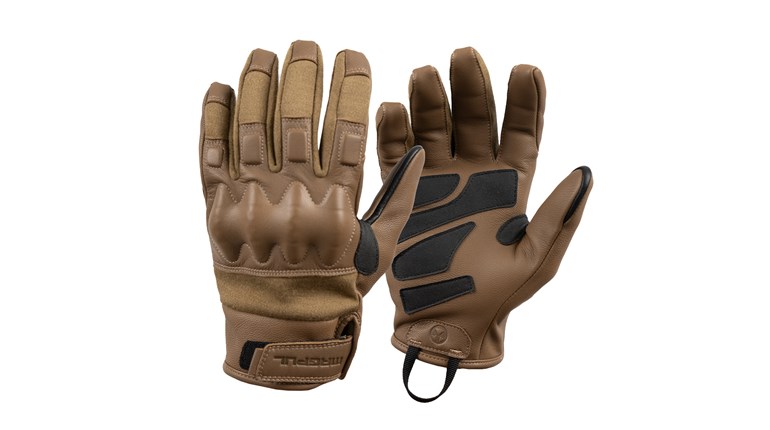
The flash flood had washed out the trail, leaving a narrow, crumbling ledge for passage. I pushed into the earth with my trekking poles, blocking out the drop to the creek below. I imagined the force of the stream-turned-torrent that had ripped away the ground, silently appreciating my sole-gripping Kenetreks and the fact my Stone Glacier pack and rifle were well balanced. Had this been the real deal, surely I’d have already hit higher ground to avoid the treacherous slip-and-slide. But then, Mother Nature’s storms can be sudden, leaving minimal time to react. Fortunately, this encounter was but one of numerous mental and physical exercises of Magpul Core’s inaugural Backcountry Hunter’s Course.
■■■
The NRA is sending you—the most accident-prone person everyone knows—to attend the Magpul course?” brother Joe asked, half amused, half concerned. “You’ll survive in the backcountry for five days?”
“No, the first two days we’ll shoot on the range, then we’ll go on a three-day, 21-mile backpack trip to Mount Rainier,” I said. I’d hunted around the world, enjoyed testing my limits in karate and the gym and took pride in pushing past my goals. Still, Joe shot back, “You know Mount Rainier is a 14,000-foot, active volcano and that several people die there each year due to falling rocks, extreme weather and hypothermia?” Fortunately, Magpul had a plan.
■■■
It was already hot as I drove to Yakima, Wash., last July to meet Magpul Core’s lead instructor—Caylen Wojcik, director of Precision Rifle Operations—and the six others participating in the two-day Precision Hunter course. A wave of intimidation hit me as my farthest hunting shot was 350 yards and my long-range experience entailed a lucky gong shot at 500. Then there was the backcountry portion. I was no whiz at pitching tents, purifying drinking water or reading a compass and topo map, but I was about to learn.
Caylen rounded us up for introductions under a shade tree that became our classroom. After eight years in the U.S. Marines, the combat-decorated scout sniper and sniper school instructor had joined Magpul to headline its training courses. He introduced us to Luke Carrick, owner of Guiderite Adventures, who he’d teamed with to customize our course. Next up was assistant instructor and former Marine scout sniper Tim Estell, and fellow students Christy, Ty, Bill, Jason, Daniel and Robert.
Providing a course overview, Caylen said, “Too many people want to learn the tricks of the trade before they learn the trade. Establishing fundamentals avoids mistakes.” We represented 1 to 2 percent of shooters who would put egos aside to train, he said. The goal was not just to ensure responsible shots on game but to teach us how to use our scope turrets and reticles to make calibrated ballistic drops, making repeatable adjustments for windage and elevation. I thought of how some hunters shoot a few times on the range to zero their rifles then can’t shoot an elk at 300 yards. The lesson: Train under the scenarios in which you’ll hunt.
We reviewed Caylen’s “circle of components”: the firearm, optic, ammo and shooter—four variables hunters must constantly manipulate. “You can have a $6K rifle and a $4K scope, but if you can’t be effective, all you have is a pile of metal and glass.” he said that in exacting precision, the firearm must be accurate and shoot 1 MOA; the optic must magnify the target and ensure proper target ID; the ammo must deliver terminal performance; and the shooter must apply marksmanship fundamentals.
Day one was for shooting prone. We’d be making use of the dope cards we’d been handed to fill in with our data. (Dope, the military term for “Data Observed from Prior Engagements,” indicates how a gun and ammo perform in given conditions.) No memorizing where to hold at 300 yards?
We reviewed the prone position: proper rifle-butt placement; cheek weld; grip; position of the shooting elbow, non-shooting elbow and rifle; and the amount of body weight to put on the bipod. I thought, I’m good. Then I couldn’t get past cheek weld. Sprawled in the dirt with my .308 Browning X-Bolt, I couldn’t keep my face centered. Caylen adjusted my Bradley cheek rest. The biggest lesson: Natural point of aim is where the rifle wants to go when I’m relaxed. I noted that as I moved my feet and recentered my body to return to it after recoil.

Sweating and trying to keep dirt off my contact lenses, I wondered what our instructors had endured in the sandy conditions of Iraq and Afghanistan. I struggled to maintain field of view and shoot a gong. Focusing on crosshairs first, not the target, Caylen advised, “You only hold your breath if going underwater!” as I fired between natural respiratory pauses. In three-shot-group drills, it was the third shot that was pressure.
“And it should not surprise you when the gun goes off! Follow through, looking at the target so you know if to shoot again.”
In class we discussed ballistic computer programs for gauging trajectory. Handing us electronic tablets, Caylen said, “Type in the make and model of your rifle, the barrel twist, sight height, reticle, elevation unit—MOA or mil [we used MOA], and use the program’s bullet library to check velocity,” which in the case of my Federal .308 168-grain Sierra Match King ammo indicated 2633 fps. “Check off a zero range of 100 yards, a density altitude of 4,000 feet, a temperature of 85 degrees and a wind speed of 5.5 mph to get predicted elevations, drift in inches, drift in MOA.” Density altitude?
Caylen got to that as he explained how wind meters track wind speed, temperature, altitude, barometric pressure—and density altitude (D/A), which impacts the amount of bullet drag at a given altitude. “The air is less dense as altitude increases. There isn’t less oxygen—just less oxygen per volume,” he explained. “At sea level, you may get 2,800 fps. On a 12,000-foot sheep hunt there is less drag so shots impact higher.” I thought about Western hunts where you can have big changes in D/A with 50 degrees in the morning and 95 by afternoon. So I scanned our charts. If I’m inside the Green band—3,000 to 5,600 feet—anything in that elevation range is the same. Not so at 10,000 feet.
Occasionally there was a pop quiz. “Say you’re at 3,200 feet D/A and it’s 8 degrees,” as we followed along with our ballistic charts. “At 500 yards, Karen, how far does your .308 drop?” I knew he’d call on me. “Uh, 64 inches.” Caylen said, “So the .308 drops 64, you’ll see the .300 Win. Mag. drops 41.3 and the .270 drops 45.7. At 800 yards, the results are 225 inches, 142.8 inches and 169.7 inches. Now bump the D/A to 8,000 feet at 80 degrees. You’ll see big changes by 800 yards.” I thought of how long-range competitive shooters must compensate for spin drift to avoid a miss.
We ranged and shot five targets—at 299, 490, 645, 777 and 800 yards—as Tim shouted, “Hold center of mass and reengage.” I was nailing targets I barely saw without a scope. I fired at the 800-yard gong. Nothing—then ping! At that distance, it just took longer for the bullet to arrive.
Manipulating my scope turrets, I was no longer relegated to a 300-yard shot. But I had to watch so I didn’t accidentally make the wrong number of rotations. The lesson: If you get lost, turn turrets back to the zero stop. If I could dial out to 300 yards, I could shoot to 400 with no adjustment.
That night I pored over my charts. Considering an elk’s vitals span 20 inches, a hit 10 inches above or below the center of its chest was a kill shot. With a 100-yard zero and a D/A of 4,000 feet, the trajectory of my 168-grain, .308 projectile having a muzzle velocity of 2700 fps showed a 10-inch drop at 272 yards. Anything beyond that range required me to either hold higher or dial more elevation with my turret to correspond with 272 yards. But with a 300-yard zero (5 or so inches high at 100), I saw I could hold dead-on and hit the vitals out to 360 yards before my bullet dropped 10-plus inches, providing I did everything correctly. The lesson: Understand drop charts and how to use them—and how reticles work.
I fell asleep pondering Caylen’s reticle instruction. A front-focal plane is ideal, growing in size with the target as scope power increases. A duplex reticle provides fewer aiming points—3½ to the left, 3½ to the right … 3.5 MOA equals 1 milliradian. As for MOA vs. mil-dot reticles, most important was making sure my rifle and spotting scope had the same scale so my spotter and I were on the same page. I recalled hearing Kristy coach Ty: “Dial left 1.75 mils.”
The next morning, Magpul’s Cody Carroll joined us for the standing and kneeling positions. When standing, I learned to lock my knees and use my leg bones for support to avoid muscle fatigue and maintain natural point of aim while using my bipod for forward support. I closed and reopened my eyes to check stability, made micro foot adjustments and flipped up a bipod leg to pan.
When kneeling, sitting back on my heels, I learned to use a sandbag for ankle support. I also realized why every hunting rifle needs a bipod. The target with the white stripe … 575 yards. Come up 14.8 clicks. Ping! The lesson: If I didn’t maintain natural point of aim, I was quickly outside my target constraints.
Another lesson: Slings aren’t just for carrying rifles. We practiced with the Magpul MS1 around our triceps. “This is one tested sling,” said Cody. “We ran 30,000 cycles with it in wet, dry and sandy conditions. Then we did static and dynamic 350-pound load testing.” The former Marine also tested it on 15 skydives and swimming drills—with rifle attached. Our very own MacGyver.
Wrapping up the Precision Hunter course, Caylen said, “Increase your comfort zone, practice with tripods and shooting sticks, expose yourself to different positions in actual hunting conditions. If you overcall the wind, is it a gut shot? A brisket shot? Do what you can to put more tools in your box.”
To prep for our simulated backcountry hunting drills, homework included using the ballistic program to fill out data cards for Brown (600-3,000 feet in elevation), Green (3,000-5,600 feet), Yellow (5,600-8,800 feet) and Orange (8,800-12,800 feet) conditions to distances of 800 yards. Curious, I compared the performance of various calibers. A .223 keeps up with a .300 Win. Mag. at 300 yards, for example, so these programs can help us make optimal choices for hunting. Filling out cards for my .308, Yellow covered elevations of 5,600 to 8,800 feet. So at 800 yards, I go up 25.0 and right 2.8.Orange covers 8,800 to 12,800 feet. At 500 yards, the bullet drops 58.3 inches. Go up 11.1 and right 1.4. Look at me getting the most out of my equipment. If you hone Magpul’s fundamentals and know you can make the shot, there is no issue.
■■■
At daybreak we met at the foothills of the Cascade Mountains for a massive gear shakedown, spreading our items for Luke’s inspection before hitting the trailhead. (See sidebar for gear list.) A 20-year backpack veteran, he hit the hills twice a month in all weather conditions. “No military trained person is any better,” Caylen said of the person who’d taught him everything he knew about backcountry hunting. So for the next three days MAGPUL stood for Mighty, Agile, Geared People Under Luke.
Day one showed what it took to go 10 of our trip’s 21 miles. “We’re only going 10 because we want this to be fun!” Caylen said. How far would we go if they didn’t want us to have fun? Electrolytes, water, food plans, avoiding blisters and proper position of one’s backpack and rifle were center stage.

As Luke used Caylen as a backpack model, demonstrating how a pack’s weight should rest on our hips—not our backs—and how much to tighten the straps, I thought how engaging they were. The training was effective, practical and beneficial.
■■■
Just a little farther,” Caylen said, as we ascended the trail single-file. It got tougher to chat amongst ourselves as heart rates increased. “But it was ‘just a little farther’ 20 minutes ago,” Robert said. We’re catching on to all this mind-over-matter training. Snagging the protein bar in my pocket, I appreciated how the “cool wool” of my Duckworth Vapor Wool T-shirt worked like blotting paper. As we rounded a bend, we met two hikers who made way so we could pass. Magpul train coming through.
We stopped for water, lunch and to swap out sweaty socks. Caylen talked topo maps as we learned to determine terrain features—ridges, valleys, depressions, draws.
Hours later, though enjoying the workout, I, too, wondered where trail’s end was when Luke said, “Fifteen more minutes”—again. I witnessed the importance of fitness and hydration firsthand as Luke, Caylen and Cody took turns with Robert’s pack while simultaneously carrying theirs.
Finally arriving, we spotted mountain goats on the hill as we dropped our packs, pitched our tents, hit the creek for water and prepared our freeze-dried meals. I devoured my pouch of Mountain House chicken and potatoes. At sunset, we glassed the goats with Mount Ranier’s peak to our backs—the most glaciated in the Lower 48. I crawled in my tent wishing it were hunting season and I had a goat tag.
Luke woke us early to glass as animals began moving, then gathered us for instruction. “So why did we place our tents here?” he asked. “So we ’re on the back side of the basin we’re working. Use trees to block your tent, never make a fire, and stay hidden from animals and people.”
Then we reviewed the best times to glass and how animals move. “Consistency and patience are how you learn the trails animals use—and at what time,” he said, as he taught us to practice scanning patterns—left to right, top to bottom. “When you see an animal, find a reference point so you don’t lose it. Pick trees apart all day long.”
Then it was onward and upward. Covering hiking techniques, he instructed, “Plant your foot and place all your weight on it as you lock your knee for stability before taking the next step,” he said. “We’re only going 6 miles today, though yesterday’s hike was as cush as it gets because we used a trail.” More advice: “Plan your meals and eat whether you’re hungry or not. A peanut butter and bacon sandwich is like rocket fuel.”
We stopped to pump water then hiked to the site of our timed hunters’ drill. As in the military, training ensured accurate shots regardless of target difficulty due to distance, size or position. We covered both marksmanship and survival skills in battle—or in this case, the hunter’s woods—to maximize effectiveness and minimize risk. I kept pace with Luke, thanking God I was a cardio nut, as he stressed how ultimately going off trail was how to find trophy animals.
As we waited our turn to locate and shoot targets under realistic hunt conditions in Luke’s hunters’ drill, Cody had us finding map points using our compass, map and a protractor I hadn’t used since geometry class. I learned to orient my map and use my compass to get bearings between points. Fingers were lines, spaces were draws. Close contour lines meant cliffs or steep terrain. Using the map’s number system, we read from the right then up. Safety tip: Check your position as you go so you always know where you are. Easy enough. Then he started on declination maps, which show deviation from True North to Grid North and Magnetic North. Did school-of-infantry students feel this overwhelmed?
“If you don’t have a compass, make one,” he said, creating a sundial with a piece of paper and a stick. “From the 12 o’clock line, make the stick perpendicular to the pole of the earth.” I imagined him in Afghanistan, perhaps building a hang glider with parts from a crashed satellite to escape the enemy.
When it was my turn to shoot, I tried to make out the position of the hidden targets, perching on a cliff rock. I’d come a long way. Then we hiked to simulation drill No. 2.
Heading for a new camp spot, Bill said, “Sometimes it’s fun to be dumb, but it pays to be smart,” as Ty, who turned out to be a botany expert, pointed out the plants we could not eat. Outdoor survival skills were handy.
Seeing Robert struggle the last mile, I passed along my canister of O2 Unleashed, 95 percent pure oxygen for natural energy and recovery. He hung back with Tim and Caylen. The lesson: Backcountry preparedness is even more critical when fatigued. That final mile seemed like two.
We camped along a stream, and circled around the campfire Caylen taught us to build with flint and steel. During a final orienteering session, the wilderness again offered multiple opportunities for failure.
Come morning we trekked our final 5 miles and visited two waterfalls—an amazing end to an amazing trip! Marching to the finish line, I pondered the training daily life was about to pull me away from as I committed many a Magpul lesson to memory.



































